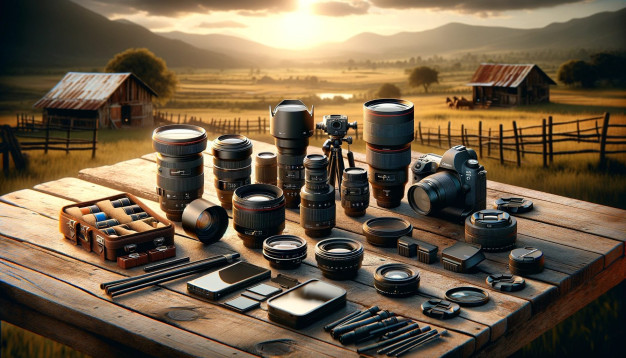Camera Gear 101 for Newbies
Master the basics of cameras, lenses, and accessories with our beginner's guide.

Introduction to Camera Gear
Understanding Camera Types
Camera types range from user-friendly point-and-shoots to professional-grade DSLRs and mirrorless systems. Choosing the right type hinges on your photography style and goals.
Importance of Camera Gear
Gear doesn’t make the photographer, but it sure can help. Good equipment can enhance image quality, expand creative possibilities, and survive a newbie’s learning curve without breaking apart.
Camera Bodies
DSLR Cameras
DSLRs are the beefy textbooks of photography: a bit bulky but full of potential. They boast optical viewfinders and long battery life, ideal for learning the ropes of manual settings.
Mirrorless Cameras
Mirrorless cameras are the sleek e-readers to the DSLR’s textbook. They’re lighter, often faster, and come with electronic viewfinders, making them a cutting-edge alternative.
Point-and-Shoot Cameras
Point-and-shoots are the pocket-sized novellas of cameras: straightforward and ready to go. They won’t intimidate you with complex settings, making them perfect for spontaneous adventures.
Lenses
Understanding Focal Length
Focal length, measured in millimeters, is the lens’s zoom level. Think of it as your camera’s telescope—high numbers bring distant objects closer, while low numbers capture wider scenes.
Prime vs. Zoom Lenses
Prime lenses have a fixed focal length—like a one-trick pony with a darn good trick. Zoom lenses are the Swiss Army knives, flexible but sometimes compromising on image quality.
Lens Compatibility
Not all lenses fit all camera bodies. It’s like dating—you’ve got to find a match with the right mount and communication skills (electronic contacts).
Memory Cards
Types of Memory Cards
SD, microSD, CFast, XQD—memory cards come in more flavors than your local ice cream shop. SD cards are the most common, fitting into most cameras like a glove.
Speed and Capacity Considerations
Speed (write/read) is the card’s sprinting pace—important for burst shooting and video. Capacity is its stamina, determining how much it can store before you need a break.
Tripods and Stabilization
Tripod Basics
A tripod is the three-legged therapist for shaky hands, ensuring sharp images when the light is low or the zoom is high. They come in various weights and strengths—choose one that can bear your camera’s burden without groaning.
Monopods and Gimbal Stabilizers
Monopods are the tripod’s one-legged cousin, great for mobility. Gimbals are the ninjas of stabilization, using motors to balance the camera even when you’re moving like you’ve had too much caffeine.
Camera Bags and Protection
Choosing the Right Camera Bag
Bag choices range from the incognito backpacks to the ready-for-anything shoulder bags. Pick one that doesn’t scream “Expensive gear here!” and fits your kit snugly.
Protective Gear for Your Equipment
Your camera gear is like a pet—it needs protection from the elements. Lens caps, camera armor, and weatherproof cases are the umbrella, leash, and raincoat for your gear.
Essential Accessories
Spare Batteries and Chargers
Without power, your camera is as useful as a chocolate teapot. Always pack a spare battery or two, and a charger, lest you miss the shot of a lifetime.
Filters and Lens Hoods
Filters are the sunglasses for your lens, protecting it from glare and enhancing colors. Lens hoods are like sun visors, blocking unwanted light and reducing lens flare.
Remote Shutter Releases
A remote shutter release is like extending your arm 10 feet to take a photo without jostling the camera. Essential for long exposures or when you want to sneak into the frame.
Maintenance and Care
Cleaning Your Camera and Lenses
Your gear accumulates gunk like a magnet. A blower, brush, and microfiber cloth will keep your lenses and sensor spotless, like a diligent dental routine for your camera.
Storing Your Camera Gear
When not in use, store your gear in a dry, cool place. Think of it as tucking your camera into bed, safe from the boogeymen of mold and humidity.
Conclusion
Recap and Next Steps for Newbies
You’ve now got the roadmap to navigate the bustling city of camera gear. Remember, while gear can be replaced, the moments you capture with it are once in a lifetime. So, arm yourself with knowledge, and let your creativity soar. Happy shooting!